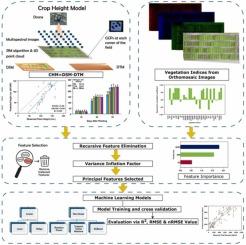利用无人机多光谱成像和机器学习技术估算工业大麻(Cannabis sativa L.)植株高度、氮素吸收和地上生物量
IF 6.2
1区 农林科学
Q1 AGRICULTURAL ENGINEERING
引用次数: 0
摘要
工业大麻(大麻sativa L.)以其高纤维产量和低生态足迹而闻名。氮素(N)状况、茎生物量(SB)和地上总生物量(AGB)对作物纤维的数量和品质影响很大。传统的监测做法是劳动密集型和耗时的。带有成像传感器的无人驾驶飞行器(uav)可能是缓解这些挑战的一个很有前途的工具。本研究评估了配备多光谱相机的无人机在预测关键农艺参数(即株高(PH)、叶片氮吸收(LNU)、SB和AGB)方面的性能。田间试验于2021年和2022年在佛罗里达州杰伊的UF/IFAS西佛罗里达研究和教育中心进行,包括两个品种和6个氮肥处理。通过作物高度模型估算PH值,在作物完全成熟(种植后90天)时,其R2为0.87。提取27个植被指数(VIs),并通过调整方差膨胀因子(VIF<10)递归特征消除(Recursive Feature Elimination)选择PH和VIs等特征,建立机器学习模型,用于估计产量成分。支持向量机模型预测LNU效果最好,R2、RMSE和nRMSE %分别为0.364、34.55 kg N ha−1和68.48。随机森林回归预测SB和总AGB最准确,R2、RMSE和nRMSE %分别为0.752和0.707、890.70和1492.73 kg ha−1、48.86和43.05。结果表明,无人机的潜力产生更可靠的PH, SB和总AGB的估计,而它仍然不可靠的LNU。本文章由计算机程序翻译,如有差异,请以英文原文为准。

Estimating plant height, nitrogen uptake and above-ground biomass using UAV multispectral imaging coupled with machine learning in industrial hemp (Cannabis sativa L.)
Industrial hemp (Cannabis sativa L.) is known for its high fiber production with lower ecological footprint. Nitrogen (N) status and stem biomass (SB) and total above-ground biomass (AGB) of the crop highly influence fiber quantity and quality. Conventional monitoring practices are labour intensive and time consuming. Unmanned Aerial Vehicles (UAVs) with imaging sensors can be a promising tool for mitigating these challenges. This study evaluated the performance of multispectral camera-equipped UAV in predicting key agronomic parameters, i.e., plant height (PH), Leaf Nitrogen Uptake (LNU) and SB and AGB. Field trials were conducted at UF/IFAS West Florida Research and Education Centre, Jay, FL during the years 2021 and 2022 consisting of two cultivars and six N treatments. The PH was estimated through Crop Height Model, yielding an R2 of 0.87 at full crop maturity (90 days after planting). Twenty-seven Vegetation Indices (VIs) were extracted and features, including PH and VIs, were selected through Recursive Feature Elimination with adjusted Variance Inflation Factor (VIF<10) to develop machine learning models for the estimation of yield components. The LNU prediction was best with Support Vector Machine model with R2, RMSE and nRMSE % value of 0.364, 34.55 kg N ha−1 and 68.48 respectively. Random Forest Regressor predicted the SB and total AGB most accurately with R2, RMSE and nRMSE % value of 0.752 and 0.707, 890.70 and 1492.73 kg ha−1, 48.86 and 43.05 respectively. The results demonstrate the potential of UAVs to generate more reliable estimates of PH, SB and total AGB whereas it remained unreliable for LNU.
求助全文
通过发布文献求助,成功后即可免费获取论文全文。
去求助
来源期刊

Industrial Crops and Products
农林科学-农业工程
CiteScore
9.50
自引率
8.50%
发文量
1518
审稿时长
43 days
期刊介绍:
Industrial Crops and Products is an International Journal publishing academic and industrial research on industrial (defined as non-food/non-feed) crops and products. Papers concern both crop-oriented and bio-based materials from crops-oriented research, and should be of interest to an international audience, hypothesis driven, and where comparisons are made statistics performed.
 求助内容:
求助内容: 应助结果提醒方式:
应助结果提醒方式:


